The Challenges and Promise of Computerized Physician Order Entry CPOE Systems: - PowerPoint PPT Presentation
1 / 14
Title:
The Challenges and Promise of Computerized Physician Order Entry CPOE Systems:
Description:
Ex: Antibiotic Renewal Failure--Therapy Gaps ... Observed a gap in antibiotic therapy because of unintended delay in re-approval of antibiotic. ... – PowerPoint PPT presentation
Number of Views:156
Avg rating:3.0/5.0
Title: The Challenges and Promise of Computerized Physician Order Entry CPOE Systems:
1
The Challenges and Promise of Computerized
Physician Order Entry (CPOE) Systems
Reexamination and New Data
- Ross Koppel, Ph.D. Sociology Department and
Center for Clinical Epidemiology Biostatistics,
University of Pennsylvania - AHRQ Conference on Healthcare Information
Technology, June, 2005
2
Our Study
- Role of Computerized Physician Order Entry
Systems in Facilitating Medication Errors - JAMA, March 9, 2005
- Koppel, Metlay, Cohen, Abaluck, Localio, Kimmel,
Strom
3
Reaction to Our Article
- Thousands of articles, comments, press releases,
attacks, and support - J. of Biomedical Informatics 4 papers on our
work JAMA 6 letters - Informatics community Of course, just good
data. - Vendor community Irrelevant because it was old
system
4
Our Studys Genesis
- The role of hospital workplace stressors (e.g.,
shifts, sleeplessness, new rotations) on
housestaff medication prescribing errors. - The CPOE system emerged as a study focus when
housestaff repeatedly told us it caused stress
and error
5
Findings 22 medication error risks facilitated
by CPOE
- I. Information Errors generated by fragmentation
of data and failure to integrate the hospitals
several computer and information systems - II. Human-Machine Interface Flaws Reflecting
machine rules that do not correspond to work
organization or usual behaviors
6
Ex Assumed Minimum Dose Assumed Dose Range
Information
- 73 of housestaff use CPOE displays to determine
low doses 82 used CPOE displays to determine
range of doses. 40 used CPOE to determine
dosages at least a few times weekly 10 to 14
daily. New Systems Differences
7
Ex Medication Discontinuation Failures for
several hours Not canceling medication because
of fragmented CPOE
- Reported by 51. 22 indicated this occurs a few
times weekly, daily or more frequently.
8
Ex Antibiotic Renewal Failure--Therapy Gaps
- 83 of housestaff observed gaps in antibiotic
therapy because of unintended re-approval delays.
27 reported this occurs a few times weekly 13,
once daily or more frequent. New System RNs
save us
9
Patient Selection--Screen Design Inconsistent
Color/Font Coding
- 55 of housestaff Difficulty identifying the
patient they were ordering for because of
fragmented CPOE displays 23 say this happened a
few times weekly or more frequently. New
system Foolish Observation
10
Ex Wrong Medication SelectionMultiple Screens
- 72 of housestaff report they were often
uncertain about medications and dosages due to
difficulty in viewing all the medications on one
screen
11
Our RECOMMENDATIONS Concentrate on Organizational
Factors (1-3 of 5)
- 1. Focus primarily on the organization of work
not on technology. CPOE must only determine
clinical actions if they improve care. - 2. Aggressively examine the technology in use.
Problems obscured by workarounds, medical problem
solving ethos, and low housestaff status. - 3. Substitution of technology for people is a
misunderstanding of both. Aggressively fix
technology when shown to be counter-productive.
Failure to do so engenders alienation and
dangerous workarounds.
12
Our RECOMMENDATIONS Concentrate on Organizational
Factors (4-5)
- 4. Episodic and incomplete error reporting are
standard. Management belief in these reports
obfuscates and compounds problems. Pursue errors
second stories. - 5. Plan for continuous revisions and quality
improvement recognizing that all changes
generate new error risks.
13
Preview of New Findings
- Have studied NEW system (SCM) in same hospital
with same and new cohorts - Asked same questions in same format
- Few improvements surprise to us
- 1. fewer crashes
- 2. lack of guidance on dosages (sic)
- 3. Others No improvement or worse
14
Coda Questions and Issues
- New Research still to be explored
- Response by IT vendors and friends
- Increasing Acceptance New articles within past
few weeks - Your questions?
- Ross Koppel, Ph.D. Sociology Dept. and Center
for Clinical Epidemiology Biostatistics, Univ
of Penn. rkoppel_at_sas.upenn.edu































